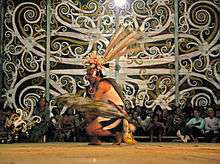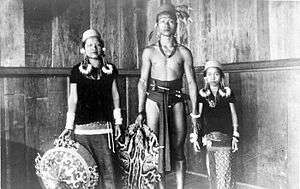Kenyah people
|
A young Kenyah family in East Kalimantan, pre-1944. | |
| Total population | |
|---|---|
| 69,256 (year 2000 - Malaysia and Indonesia)[1][2] | |
| Regions with significant populations | |
|
East Kalimantan (24,700)[3] West Kalimantan | |
| Languages | |
| Kenyah languages, Mainstream Kenyah language | |
| Religion | |
| Christianity (predominantly), Islam and Bungan | |
| Related ethnic groups | |
| Kayan people |
The Kenyah people are an indigenous, Austronesian-speaking people of Borneo, living in the remote Baram (Lio Matoh, Long Selaan, Long Moh, Long Anap, Long Mekaba, Long Jeeh, Long Belaong, Long San, Long Silat, Long Tungan, etc.), Data Kakus, Data Surau, Sg. Senap, Long Dungan, Long Busang, Long Beyak, Bintulu, Miri, Sungai ASAP resettlement for Bakun DAM, Long Bulan, Long Jawe and Belaga regions in Sarawak, Malaysia and the remote Apau Kayan, Bahau (Bau), Benua Lama & Baru and Mahakam regions in East Kalimantan, Indonesia.
Kenyah people are divided into various tribes including the Uma Bakah, Lepo Anan, Lepo Tau, Lepu Jalan, Lepo' Tepu, Uma Kelap, Badeng (Jamok, Lepo Aga'), Bakung, Lebu Kulit, Uma Alim, Uma Timai, Uma Lasan, Lepo Ma-ut, Sambop, Lepo Ke', Lepo Ngao, Ngurek, Kiput, Long Ulai, Long Tikan, Long Sabatu, Lepo Ga, Lepo Dikan, and Lepo Pua
Culture and economy

The Kenyah people, traditionally being swidden agriculturalists and living in longhouses (uma dado'), is an umbrella term for over 40 sub-groups that mostly share common migration histories, customs and related dialects. Kenyah people lived in longhouses in a small communities. Each longhouse consists of families who choose their own leader (headman). When they have any event or celebration such as harvest festival they will normally use the longhouse verandah (oseh bi'o) to gather and deliver speeches to guide their youngsters. Normally this harvest festival celebration (tau bio Ramay o o Ajau, pelepek uman) is a major festival because most of them are still farmers.
Kenyah people are very creative and they also have composed their popular songs and melody such as Lan e Tuyang, Kendau bimbin, Ilu Kenyah Kua Lo Te'a, Pabat Pibui, Atek Lan and Leleng Oyau Along Leleng. Our Kenyah popular music instruments are jatung utang, sampe, sampe bio (bass, with 1 string), lutong and keringut.
Religion
Many Kenyah people are Christian but significant number of Kenyah people are now become Muslim. Initial they believed in 'Bungan Malan Peselong Luan' (a traditional form of animism) before the conversion. But now there are only a small number of Kenyah people still believe in Bungan. When they die they believe they will be ascended to Alo Malau (seven heavens) with their ancestors (tepun).[4]
Population
Statistical figures, based on the Indonesian and Malaysian national censuses collected in 2000, recorded a total of 44,350 Kenyah people in East Kalimantan and 24,906 in Sarawak.[5]
Sub-ethnic groups
The Kenyah people are also divided into various sub-ethnic groups such as:-[6]
- Kenyah Badeng
- Kenyah Lepo' Bam
- Kenyah Lepo' Jalan
- Kenyah Lepo' Tau'
- Kenyah Lepo' Tepu
- Kenyah Lepo' Ke'
- Kenyah Uma' Tukung
- Kenyah Uma' Baka
- Kenyah Lepo' Maut
- Kenyah Lepo' Agak
- Kenyah Bakung
- Kenyah Lepo' Timai
- Kenyah Lepo' Kulit
- Kenyah Uma' Lasan
- Kenyah Uma' Lung
- Kenyah Uma' Kelep
- Kenyah Lepo' Gah
- Kenyah Lepo' Anan
Origins

The Usun Apau (aka Usun Apo) plateau (in the Plieran river valley) or Apo Kayan Highlands (a remote forested plateau in Malaysian and Indonesian border) in the present-day Indonesian province of East Kalimantan was the largest concentration site of Kenyah populations between the late 19th century to the early 1980s.
Languages
The Kenyah languages are a small family of Austronesian languages. Their language is called is Kenyah.
Folk songs
- Leleng-Leleng[7]
- Leleng[8]
- Ake' Mimbin Iko' Tuyang[9]
- Pabat Pibui[10]
- Daleh Lenca dalem bada [11]
- Ayen Palo boka tai mutu leto [12]
Notable Kenyah people
- The late Dato' Sri Temenggong Oyong Lawai Jau(1950-1974) from Long San, Member of PANAS (Parti Negara Sarawak) then join SNAP (~1962), Paramount chief of Baram Kenyah and Kenyah Hura
- The late Tama Weng Tingang Member of Parliament of Baram (Sarawak United People's Party)
- The late Datuk Seri Joseph Balan Seling, Assistant Agriculture and Community Development Minister (1976), Former state minister for local Government (1986), Senator (1998–2000), six-term assemblyman of Telang Usan[13]
- Dato' Jacob Dungau Sagan, Baram, Miri MP, ex-Malaysian Deputy Minister of International Trade and Industry, Member of SPDP & Senior Vice-President of the Sarawak Progressive Democratic Party (SPDP)
- Dr. Drs. Marthin Billa, MM, ex-Bupati Malinau, East Kalimantan (2001–2011)[14]
- YB Anyi Ngau, MP for Baram, ex-District officer for Tatau & ex-D/O for Limbang
- Pastor Robin Ato, BEM, Miri, BEM Sarawak ex-Secretary-General[15]
- Langit Bit - field of Kenyah traditional medicine
- Raymond Abin, Environmentalist and social activist, Asian representative of the International Alliance of Indigenous peoples to the UNDRIP, Geneva, 2004-2006 and founder of Borneo Resources Institute Malaysia.
- Lucas Kalang, footballer & MSNS Football Development director
- Dr. Francis Jana Lian, Borneo rainforest vanilla, UBD Dept of Geography
- Philip Lepun, academician UPM
- Roland Engan, lawyer
- David Abun Sui Anyit, (Sarawak Indigenous Lawyers Association / SILA), lawyer focused on NCR issues[16]
- Jimpau Balan, Asang Lawai, Tegit Usat, Mathew Ngau Jau, Sageng Jateng & Ramli Ongka Bit, artiste for Sampe' Kenyah
- Daniel Bampa & Desy Tepau from East Kalimantan, Kenyah artiste
- Temenggong Joseph Ngau Lian, KM Long Silat
- Pemanca Tony Kulleh, for Sg Asap
- Penghulu Paul Kalang, Baram
- Penghulu Surat Kuja, Belaga
- Penghulu Nyurang Uloi, Lg Geng
- Penghulu Katan Lawai, Sg Asap
- Penghulu Joseph Beluluk, Lg Aton - Tinjar
- Henry C. Belawing, Lg. San/Kuala Tutoh - Administrative Officer/Researcher (Adet Kayan-Kenyah 1994) Majlis Adat Istiadat, Sarawak
- Vom Roy, The study on the migration of Kenyah[17] / President Of Kenyah Badeng Sarawak(KEBANA)
- Peter Nicodimus Jalong Kallang, anti-dams activist and Chairman of SAVE Rivers
- Reniu Sageng, Sejarah Adet Pengelan Kenyah dan Badeng [18]/ Sejarah Layan Pengudip Kenyah Badeng [19] / Secretary Of Kenyah Badeng Sarawak (KEBANA)
Joseph Kalang Tie, footballer and represent Malaysia National Team
References
- 1 2 William W. Bevis (1995). Borneo Log: The Struggle For Sarawak's Forests. University of Washington Press. ISBN 9780295974163.
- ↑ PeopleGroups
- ↑ "Kenyah, Mainstream". Joshua Project. Retrieved 2015-01-07.
- ↑ http://rensraul.blogspot.com/2008/12/penganut-kristen-long-busang.html
- ↑ See 2000 National Census, Jawatan Perangkaan Malaysia, 2000 and 2000 Population Census /Sensus Penduduk 2000, Central Bureau of Statistics Indonesia, 2000
- ↑ "Languages of Borneo". Digital Atlas of Indonesian History. Retrieved 2015-01-07.
- ↑ "LELENG-LELENG". YouTube. Retrieved 2014-11-29.
- ↑ "Leleng". YouTube. Retrieved 2014-11-29.
- ↑ "Ake' Mimbin Iko' Tuyang". YouTube. Retrieved 2014-11-29.
- ↑ "Pabat Pibui". YouTube. Retrieved 2014-11-29.
- ↑ https://www.youtube.com/watch?v=TO_e0CmHcSk
- ↑ https://www.youtube.com/watch?v=WP2rk4iA73o
- ↑ "Former minister Balan succumbs to illness". mysarawak.org. 15 March 2010. Retrieved 18 August 2012.
- ↑ Agus Andrianto (2006). The Role of District Government in Poverty Alleviation (PDF). The Center for International Forestry Research (CIFOR). p. 9. ISBN 979-24-4636-2. Retrieved 18 August 2012.
- ↑ "Insurance benefit for deceased Sarawakian pastor's family". Berita NECF. Puchong, Selangor, Malaysia: National Evangelical Christian Fellowship of Malaysia: 13. March–April 2008. Retrieved 18 August 2012.
- ↑ "Constitutional Law Committee (2012/2013)". The Malaysian Bar. 7 August 2012. Retrieved 18 August 2012.
- ↑ Chee-Beng, Vom Roy ; edited with an introduction by Tan (1993). The migration of Kenyah Badeng : a study based on oral history. Kuala Lumpur: Institute of Advanced Studies, Universiti Malaya. p. 65. ISBN 9839576186.
- ↑ http://rensraul.blogspot.my/2010/05/buku-adet-pengelan-kenyah-badeng.html
- ↑ http://rensraul.blogspot.my/2010/05/buku-layan-udip-kenyah-badeng.html
Further reading
External links
- Kenyah Uma Vaha website
- United Nations University's Our World 2.0 "Forbidden forest of the Dayak people" Digital Video: In Setulang village, near the Malay-Indonesian border, lives the “Oma’lung” tribe — a particular sub-group of Kenyah Dayak, East Kalimantan, Indonesia, on the island of Borneo
- Kaipuleohone's Robert Blust collection includes written notes on many different varieties of Kenyah.
| Wikimedia Commons has media related to Kenyah. |
